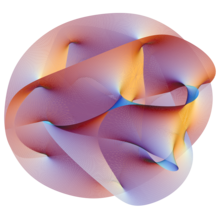AdS/CMT對偶
外觀
在理論物理學中,AdS/CMT對偶(英語:AdS/CMT correspondence),全稱反德西特/凝聚體理論對偶(英語:Anti-de Sitter/condensed matter theory correspondence)是指通過利用AdS/CFT對偶將弦理論應用到凝聚體理論中。
幾十年來,實驗凝聚體物理學家發現了許多物質的奇異狀態,包括超導態、超流態和玻色–愛因斯坦凝聚態等。這些狀態可以用量子場論來解釋,但是一些現象使用標準的場論方法難以得到很好的解釋。一些理論凝聚體物理學家希望AdS/CFT對偶可以用來描述這些系統,並更多地了解它們的性質。[1]
進展
[編輯]目前在解釋超流體向絕緣體轉變的問題上,弦論方法已經取得了一定的成功。超流體是一種由電中性原子組成的系統,流動時沒有任何阻力。實驗室中通常用液氦來產生這樣的物質,但是最近實驗物理學家發展了產生人工超流體的新方法:將數以萬億計的冷原子倒入交叉雷射形成的格子中。這些原子最初表現出超流體的性質,但在雷射強度增大的條件下最終轉變為絕緣體。轉變過程中,原子的性質十分不尋常,最近物理學家認為這可以表示一種對偶(英語:dual,不是correspondence):流體可以用類似於黑洞的場論來描述。[2]
質疑
[編輯]儘管許多物理學家開始使用弦論的方法來研究凝聚體物理學,一些這個領域的理論家對AdS/CFT對偶是否能為建立現實世界中系統的模型提供有效工具。在給《今日物理》(Physics Today)的一封信中,諾貝爾物理學獎獲得者菲利普·安德森寫道:[3]
| “ | 凝聚體理論中的AdS/CFT方法是一個非常寬泛的話題,我們可以關注最初的引導者「CFT」——共形場論。凝聚體問題總體上既不是相對論性的也不是共形的。在臨近量子臨界點時,時間和空間可能發生縮放,但是儘管這樣我們還是有更好的坐標系,通常是晶格。有一些證據表明奇異金屬左側的其他線性T相與他們的推測可能相符,但是這種情況下凝聚體問題又是由實驗事實超定的。[4] | ” |
參見
[編輯]注釋
[編輯]- ^ Merali 2011, p.303
- ^ Sachdev 2013, p.51
- ^ Anderson, Philip. Strange connections to strange metals. Physics Today. [14 August 2013]. (原始內容存檔於2013-08-15).
- ^ As a very general problem with the AdS/CFT approach in condensed-matter theory, we can point to those telltale initials "CFT"—conformal field theory. Condensed-matter problems are, in general, neither relativistic nor conformal. Near a quantum critical point, both time and space may be scaling, but even there we still have a preferred coordinate system and, usually, a lattice. There is some evidence of other linear-T phases to the left of the strange metal about which they are welcome to speculate, but again in this case the condensed-matter problem is overdetermined by experimental facts.
參考資料
[編輯]- Merali, Zeeya. Collaborative physics: string theory finds a bench mate. Nature. 2011, 478 (7369): 302–304. Bibcode:2011Natur.478..302M. PMID 22012369. doi:10.1038/478302a.
- Sachdev, Subir. Strange and stringy. Scientific American. 2013, 308 (44): 44. Bibcode:2012SciAm.308a..44S. doi:10.1038/scientificamerican0113-44.
- Sachdev, Subir. Condensed matter and AdS/CFT. 2010. arXiv:1002.2947
 .
.

